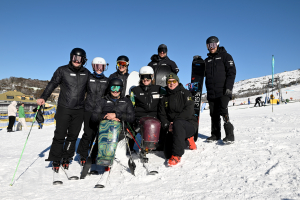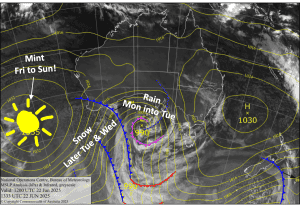AVALANCHES KILL – Are you in danger of the White Death?
![]()
By David Winterburn

You are skiing on a field and your mates are checking out the fresh lines in the back bowls. You are building a kicker out the back of a field. Your mate has invited you on a backcountry ski tour. It must be safe? But how do you know?
The recent death of an Australian man heli-skiing in the New Zealand Alps has brought the danger of avalanches to the forefront of media attention on both sides of the Tasman.
Without doubt avalanches are a significant hazard in the mountains. The study into avalanches is a science, but that doesn’t mean everyone using the backcountry can’t learn how to minimize the chances of being caught, and maximize their chances of survival if they are.
But what is an avalanche, and what causes them?
There are two main types of avalanches:
1. Point release (or loose snow)
2. Slab avalanches.
Point release avalanches are usually associated with new snow and rapid warming by sun or rain. They usually start on steep ground and are characterized by starting from a high point and fanning out, setting new snow into motion as they travel downhill. Although generally smaller, point release avalanches are still dangerous, especially if they sweep you off a cliff or into a crevasse.
A slab avalanche is the most deadly and is made up of a layer of cohesive snow and starts from a fracture line, which propagates across a slope, releasing the snow below it. This is the type of avalanche we most commonly hear about, and is often triggered by skiers or climbers. The avalanche that buried the three Australian heli-skiers last week was a slab avalanche.

Watch Avalanche footage here: http://www.fsavalanche.com/Default.aspx?ContentId=4&LinkId=10&ParentLinkId=9
Avalanches are caused by the layers in the snowpack:
As children we all learn that no two snowflakes are the same, and this is true of the snowpack. The snowpack isn’t uniform but rather has many different layers in it. Some of these layers are harder and stronger, whereas others are softer and weaker. For a slab avalanche to occur, a harder denser layer must overlie a weaker layer. When either the strong layers can’t support themselves, or the weaker layers can no longer hold the stronger layers, they slide causing an avalanche. A good way to think about it is the strong layers are the avalanche whereas the weak layers cause the avalanche. When you see avalanche professionals digging or probing the snow, they’re checking out the layers and the weaknesses in the snowpack. In other words they’re seeing how stable the snow is.
For an avalanche to occur there need to be three main contributing factors:
1. A trigger
2. Steep enough terrain to produce an avalanche
3. Unstable snow
1. A trigger can be naturally occurring, such as new snow, rain, sun, a cornice or it can be a person. Occasionally a naturally triggered avalanche can endanger people, and this is common in the northern hemisphere where many alpine villages and roads are located within avalanche paths. However, the majority of avalanches that injure or bury people are in fact triggered by people.
2. The terrain must be steep enough to produce an avalanche. If the slope isn’t steep enough the snow won’t be able to slide, but on the other hand, snow falls off really steep slopes regularly, so the layers required for an avalanche can’t build up. This is how skiers and boarders come into the most contact with avalanches. The slopes most at risk for producing avalanches are between 45 an 30 degrees, which are also the best for riding and skiing! This is a strong focus of avalanche training, helping people recognize and stay out of avalanche terrain.
3. The snow must be able to produce an avalanche. If the snow is stable (has no weak layers) it can’t produce an avalanche.
Understanding this side of the avalanche picture is complex and takes years of practice, and time in the mountains. Even then there are no guarantees and even the most experienced still make mistakes. Professionals such as heli-ski guides are constantly balancing snow stability, and the terrain. If the stability is poor they often look for lower angle terrain to minimize the risk. If the stability is good they can venture into more adventurous terrain. If the stability is poor and they can’t ski some low angled slopes, they simply don’t go.
Even a small avalanche can result in burial, and this is where the importance of training and knowledge comes into play. The heli-skiers who were buried last week were all wearing avalanche transceivers or beacons that allowed their guides to find them and dig them out within seven minutes. Time is a crucial in the survival rates of avalanche burial victims.
Burial & Survival Percentages:
At 18 minutes 91% of buried avalanche victims are found alive. The main cause of death under 18 minutes is from trauma, normally associated with the victim hitting something during the avalanche, or a blocked airway. This is likely to be a possible cause of death in last week’s fatality in NZ.
Survival rates drop dramatically to only 34% at 35 minutes and 7% after two hours.
Sobering statistics that reflect the importance of avalanche awareness and correct equipment for both yourself and your companions, who become your rescuers, should you be caught in an avalanche.

Avalanche Avoidance and Safety Tips:
1. Avalanche transceivers, shovels, and probes should be standard equipment for each member of your party.
2. If you’re ever caught in an avalanche your best chance of survival is being rescued by your companions, not by them going to get help, which is why you need to carry this equipment at all times. By the time helps arrives, you or your companion(s), will almost certainly be dead.
3. The best way to become familiar with basic techniques in avalanche safety is to take an Avalanche Awareness course. These courses are run throughout the winter in almost all mountainous areas. In New Zealand the Mountain Safety Council, and in North America the Canadian Avalanche Association run both short and longer courses for recreational skiers and boarders.
4. Finally, before you head into the backcountry, always check your local avalanche advisory and seek local knowledge, be it from the local ski patrol or parks service.
For further information check out the following websites:
New Zealand Mountain Safety Council
mountainsafety.org.nz
avalanche.net.nz
Otago Polytechnic Avalanche Stage One Course
(for professional avalanche education)
In Canada:
Canadian Avalanche Association
References:
1.B. Jamieson. 1989. Backcountry Avalanche Awareness. Canadian Avalanche Association, Revelstoke, Canada. Pp11.




